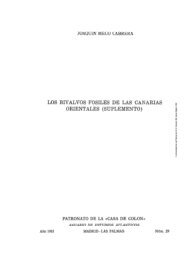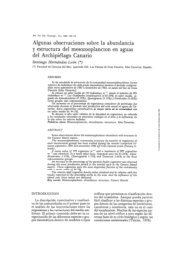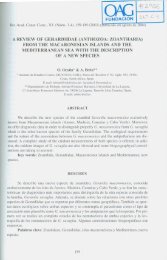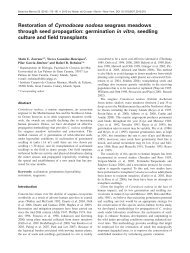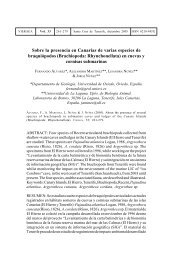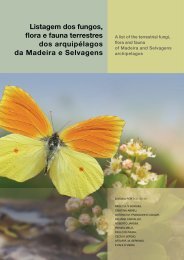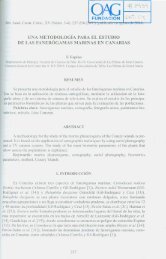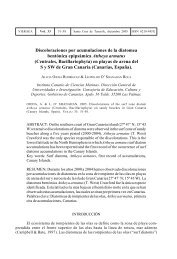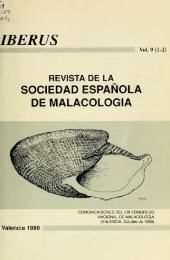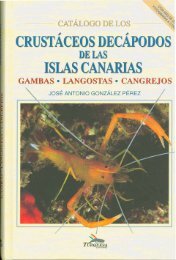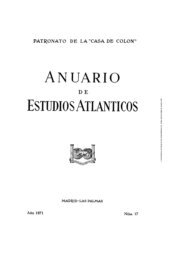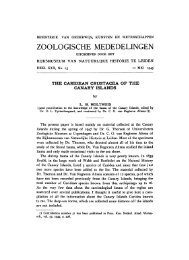Egg development and fecundity estimation in deep-sea red ... - redmic
Egg development and fecundity estimation in deep-sea red ... - redmic
Egg development and fecundity estimation in deep-sea red ... - redmic
Create successful ePaper yourself
Turn your PDF publications into a flip-book with our unique Google optimized e-Paper software.
Short communication<br />
Fisheries Re<strong>sea</strong>rch 109 (2011) 373–378<br />
Contents lists available at ScienceDirect<br />
Fisheries Re<strong>sea</strong>rch<br />
journal homepage: www.elsevier.com/locate/fishres<br />
<strong>Egg</strong> <strong>development</strong> <strong>and</strong> <strong>fecundity</strong> <strong>estimation</strong> <strong>in</strong> <strong>deep</strong>-<strong>sea</strong> <strong>red</strong> crab, Chaceon aff<strong>in</strong>is<br />
(Geryonidae), off the Canary Isl<strong>and</strong>s (NE Atlantic)<br />
Victor M. Tuset a,c,∗ , Dom<strong>in</strong>go I. Esp<strong>in</strong>osa b , Antonio García-Mederos a , José I. Santana a , José A. González a<br />
a Departamento de Biología Pesquera, Instituto Canario de Ciencias Mar<strong>in</strong>as (ICCM-ACIISI), Grupo de Biología Pesquera, P.O. Box. 56, E-35200 Telde (Las Palmas), Canary Isl<strong>and</strong>s,<br />
Spa<strong>in</strong><br />
b Departamento de Biología Animal, Universidad de La Laguna, c/Astrofísico F. Sánchez s/n, La Laguna, Tenerife, Spa<strong>in</strong><br />
c Instituto de Ciéncias del Mar (ICM-CSIC), Passeig Marítim 37-49, 08003, Barcelona, Cataluña, Spa<strong>in</strong><br />
article <strong>in</strong>fo<br />
Article history:<br />
Received 5 November 2010<br />
Received <strong>in</strong> revised form 3 February 2011<br />
Accepted 28 February 2011<br />
Keywords:<br />
<strong>Egg</strong> <strong>development</strong><br />
Fecundity<br />
Chaceon aff<strong>in</strong>is<br />
NE Atlantic<br />
1. Introduction<br />
abstract<br />
Geryonid <strong>deep</strong>-<strong>sea</strong> <strong>red</strong> crabs occur widespread throughout<br />
the world <strong>and</strong> many of them have <strong>in</strong>terest to fisheries such as,<br />
e.g., Chaceon qu<strong>in</strong>quedens Smith, 1879 <strong>and</strong> Chaceon fenneri (Mann<strong>in</strong>g<br />
<strong>and</strong> Holthuis, 1984), Chaceon maritae (Mann<strong>in</strong>g <strong>and</strong> Holthuis,<br />
1981), Chaceon bicolour (Mann<strong>in</strong>g <strong>and</strong> Holthuis, 1989) <strong>and</strong> Chaceon<br />
notialis Mann<strong>in</strong>g <strong>and</strong> Holthuis, 1989, Chaceon chilensis Chir<strong>in</strong>o-<br />
Gálvez <strong>and</strong> Mann<strong>in</strong>g, 1989 (Elner et al., 1987; Erdman <strong>and</strong> Blake,<br />
1988; Melville-Smith, 1988; L<strong>in</strong>dberg <strong>and</strong> Wenner, 1990; Arana,<br />
2000; Steimle et al., 2001; Smith et al., 2004) <strong>and</strong> Chaceon aff<strong>in</strong>is<br />
(Mann<strong>in</strong>g <strong>and</strong> Holthuis, 1989). This last species <strong>in</strong>habits the eastern<br />
Atlantic Ocean (64 ◦ N–15 ◦ N) from Icel<strong>and</strong> to Senegal, <strong>in</strong>clud<strong>in</strong>g the<br />
Azores, Madeira, <strong>and</strong> the Canary <strong>and</strong> Cape Verde Isl<strong>and</strong>s between<br />
130 <strong>and</strong> 2047 m depth (Kjenerud, 1967; Samuelsen, 1975; Mann<strong>in</strong>g<br />
<strong>and</strong> Holthuis, 1981; Sánchez <strong>and</strong> Olaso, 1985; Dawson <strong>and</strong> Webber,<br />
1991), <strong>and</strong> also know from the Mid-Atlantic Ridges i.e., Menez<br />
Gwen, Lost City (Biscoito <strong>and</strong> Saldanha, 2000; Biscoito, 2006). In<br />
the Canary Isl<strong>and</strong>s, several studies demonstrated the relative abundance<br />
of this species at depths between 600 <strong>and</strong> 1000 m (López<br />
Abellán et al., 1994; González, 1995) <strong>and</strong> some biological aspects<br />
∗ Correspond<strong>in</strong>g author at: Instituto de Ciéncias del Mar (ICM-CSIC), Passeig Marítim<br />
37-49, 08003, Barcelona, Cataluña, Spa<strong>in</strong>. Tel.: +34 928 132 900; fax: +34 928<br />
132 908.<br />
E-mail addresses: victorta@iccm.rcanaria.es, vtuset@icm.csic.es (V.M. Tuset).<br />
0165-7836/$ – see front matter © 2011 Elsevier B.V. All rights reserved.<br />
doi:10.1016/j.fishres.2011.02.021<br />
The goal of this work was to elaborate on reproductive knowledge of the <strong>deep</strong>-<strong>sea</strong> <strong>red</strong> crab, Chaceon aff<strong>in</strong>is,<br />
off the Canary Isl<strong>and</strong>s by provid<strong>in</strong>g <strong>in</strong>formation regard<strong>in</strong>g its egg <strong>development</strong> <strong>and</strong> <strong>fecundity</strong>. Six stages<br />
for eggs were observed, from fully filled with yolk to the embryo occupy<strong>in</strong>g almost all the space <strong>in</strong>side<br />
the egg. A correlation was established between egg stage <strong>and</strong> the colour of the egg mass. Morphological<br />
analyses <strong>in</strong>dicated that the eggs are spherical <strong>in</strong> shape <strong>and</strong> that they <strong>in</strong>crease the 10.7% <strong>in</strong> maximum<br />
diameter from the <strong>in</strong>itial to the f<strong>in</strong>al stage. Fecundity (AFE, annual <strong>fecundity</strong> <strong>estimation</strong>), def<strong>in</strong>ed as<br />
the number of eggs borne per females, was calculated with two methods, manual by h<strong>and</strong> counter <strong>and</strong><br />
us<strong>in</strong>g an automated morphology system. No statistical differences for the relationships carapace width<br />
(CW)–AFE <strong>and</strong> total weight (TW)–AFE were detected between the two methods. The number of eggs<br />
ranged from 199,690 to 566,956 (105–160 mm CW). A positive correlation was obta<strong>in</strong>ed between AFE<br />
<strong>and</strong> CW (r 2 = 0.672) <strong>and</strong> TW (r 2 = 0.785).<br />
© 2011 Elsevier B.V. All rights reserved.<br />
(reproduction, sizes at maturity, population structure) have been<br />
studied (Fernández-Vergaz et al., 2000; López Abellán et al., 2002).<br />
Models of population dynamic used <strong>in</strong> the management of<br />
fishery resources require, among other factors, an <strong>estimation</strong> of<br />
<strong>fecundity</strong>. Fecundity is a general term used to describe the number<br />
of eggs produced by <strong>in</strong>dividual females (Arshad et al., 2006). In the<br />
<strong>red</strong> crabs, eggs are laid <strong>and</strong> held attached to the female pleopods<br />
under the abdomen for up to n<strong>in</strong>e months until the eggs hatch<br />
<strong>and</strong> the larvae are released <strong>in</strong>to the water column (Haefner, 1978;<br />
Erdman et al., 1991). Studies suggest that these species may not<br />
spawn annually, due to long <strong>in</strong>termoult, period for adult females<br />
(5–7 years), although it is possible that sperm could be sto<strong>red</strong><br />
for <strong>in</strong>termoult spawn<strong>in</strong>g (H<strong>in</strong>es, 1982; Lux et al., 1982: Erdman<br />
et al., 1991; Biesiot <strong>and</strong> Perry, 1995). The goal of this paper is to<br />
<strong>in</strong>crease our knowledge on the reproduction of C. aff<strong>in</strong>is <strong>in</strong> the<br />
Canary Isl<strong>and</strong>s previous to its possible economic exploitation by<br />
describ<strong>in</strong>g egg <strong>development</strong> <strong>and</strong> by estimat<strong>in</strong>g its <strong>fecundity</strong>. In<br />
addition, the application of an automated image analysis system<br />
for <strong>estimation</strong> <strong>fecundity</strong> <strong>and</strong> for egg diameter measurements <strong>in</strong><br />
crustaceans was tested.<br />
2. Materials <strong>and</strong> methods<br />
2.1. Sampl<strong>in</strong>g<br />
A total of 41 berried females were captu<strong>red</strong> from two experimental<br />
re<strong>sea</strong>rch cruises, made <strong>in</strong> February–March 2005 (n = 20) <strong>and</strong>
374 V.M. Tuset et al. / Fisheries Re<strong>sea</strong>rch 109 (2011) 373–378<br />
November–December 2006 (n = 21), co<strong>in</strong>cid<strong>in</strong>g with the spawn<strong>in</strong>g<br />
period October–May (López Abellán et al., 2002). Individuals were<br />
recollected us<strong>in</strong>g bottom traps at depths of 600–1000 m (Carvalho<br />
et al., 2007) to the south of Gran Canaria (Canary Isl<strong>and</strong>s, northeastern<br />
Atlantic) (Fig. 1). Only fresh samples, the last day of collect<strong>in</strong>g,<br />
were taken to the laboratory for the posterior study: 14 females<br />
we used for the morphological study of eggs <strong>and</strong> 30 females for the<br />
<strong>fecundity</strong> <strong>estimation</strong>. Carapace width (CW <strong>in</strong> mm) <strong>and</strong> total weight<br />
(TW <strong>in</strong> g) were taken from each crab.<br />
2.2. <strong>Egg</strong> <strong>development</strong><br />
The fresh egg mass was separated from the pleopods, placed on<br />
a mesh of 100 m, <strong>and</strong> washed with <strong>sea</strong>water under pressure to<br />
detach all the eggs. Then some eggs were placed <strong>in</strong> two Petri dishes<br />
with <strong>sea</strong>water under a compound microscope with reflected light.<br />
Four images for each Petri dish (one by quadrant) were taken <strong>in</strong><br />
each female with a digital video camera (Basler A310, Vision Technologies,<br />
Basler AG, Ahrensburg) for the automated morphology<br />
analysis (Fig. 2). Approximately, 40 eggs were measu<strong>red</strong> <strong>in</strong> each<br />
quadrant. Image-Pro Plus version 4.1.0 software (Media Cybernetics,<br />
Inc.) was used to calculate the follow<strong>in</strong>g shape parameters <strong>and</strong><br />
<strong>in</strong>dices: projected area (A <strong>in</strong> mm 2 ), maximum diameter (D <strong>in</strong> mm),<br />
m<strong>in</strong>imum diameter (d <strong>in</strong> mm), roundness (4A/( D 2 )), <strong>and</strong> aspect<br />
ratio (D/d)(Russ, 1990). <strong>Egg</strong> morphology was described <strong>and</strong> classified<br />
accord<strong>in</strong>g to Arshad et al. (2006) <strong>and</strong> Walker et al. (2006) for<br />
other brachyuran crabs, <strong>and</strong> colour changes of the egg mass consider<strong>in</strong>g<br />
previous studies <strong>in</strong> Chaceon spp. (Wigley et al., 1975; Haefner,<br />
1978).<br />
2.3. Estimation of <strong>fecundity</strong><br />
The gravimetric method was applied to determ<strong>in</strong>e <strong>fecundity</strong><br />
(AFE, annual <strong>fecundity</strong> <strong>estimation</strong>), which was def<strong>in</strong>ed as annual<br />
egg production, consider<strong>in</strong>g that spawn<strong>in</strong>g might occur only once<br />
a year, us<strong>in</strong>g a subsample of 5% by wet weight of the egg mass<br />
(Lowerre-Barbieri <strong>and</strong> Barbieri, 1993). Two methodological procedures<br />
were applied: (a) <strong>in</strong> method 1 (February–March sample), the<br />
fresh egg mass was separated from the pleopods, placed on a mesh<br />
of 100 m, <strong>and</strong> washed with <strong>sea</strong>water under pressure to detach all<br />
the eggs. Then the eggs were placed <strong>in</strong> Petri dishes with <strong>sea</strong>water<br />
Fig. 1. Location of the study area.<br />
under a compound microscope with reflected light, to count the<br />
eggs us<strong>in</strong>g a h<strong>and</strong> counter. (b) In method 2 (November–December<br />
sample), fresh egg masses were sto<strong>red</strong> <strong>in</strong> 4% buffe<strong>red</strong> formal<strong>in</strong>,<br />
detached from the pleopod filaments us<strong>in</strong>g tweezers, placed on<br />
Fig. 2. Digitalized image of eggs for morphological analysis: (A) orig<strong>in</strong>al image; (B)<br />
modified b<strong>in</strong>ary image.
V.M. Tuset et al. / Fisheries Re<strong>sea</strong>rch 109 (2011) 373–378 375<br />
Fig. 3. Chromatic variation of eggs attached to pleopods until their hatch<strong>in</strong>g: (A) <strong>red</strong>-orange or light purple; (B) burgundy; (C) dark purple; (D) brownish; (E) brown; (F)<br />
grey-black. (For <strong>in</strong>terpretation of the references to color <strong>in</strong> this figure legend, the reader is refer<strong>red</strong> to the web version of the article.)<br />
Petri dishes, <strong>and</strong> counted us<strong>in</strong>g an automated imag<strong>in</strong>g system<br />
(Leica QW<strong>in</strong> St<strong>and</strong>ard, Leica Microsystems GmbH). Berried females<br />
<strong>in</strong> embryo stage (see results, stage VI) were elim<strong>in</strong>ated from the<br />
analysis, because some embryos could have hatched already. In<br />
both methods, power regressions were fitted to <strong>fecundity</strong> versus<br />
carapace width <strong>and</strong> total weight (Haddon, 1994). Analysis of covariance<br />
(ANCOVA) was used to determ<strong>in</strong>e the effect of the method on<br />
the relationships CW–AFE <strong>and</strong> TW–AFE, <strong>in</strong> which the dependent<br />
variable was the natural logarithm of the <strong>fecundity</strong>, the fixed factor<br />
the method, <strong>and</strong> the covariate the natural logarithm of CW or TW.<br />
3. Results<br />
Six <strong>development</strong> stages were observed <strong>and</strong> correlated with the<br />
colour of the egg mass (Figs. 3 <strong>and</strong> 4): stage I, egg still undivided,<br />
fully filled with yolk, <strong>red</strong>-orange or light purple colour; stage II,<br />
the free region of yolk is just visible, burgundy colour; stage III, a<br />
slight pigmentation of the eyes appears, dark purple colour; stage<br />
IV, pigmented eyes enlarg<strong>in</strong>g <strong>in</strong> moon shape, brownish colour;<br />
stage V, visible pigmented structures enlarg<strong>in</strong>g eyes, segmented<br />
appendages <strong>and</strong> abdomen appear<strong>in</strong>g, brown colour; stage VI, eyes<br />
acquir<strong>in</strong>g oval shape, embryo occupies almost all the space <strong>in</strong>side<br />
the egg, grey-black colour. After the last stage, larvae are present.<br />
<strong>Egg</strong> <strong>development</strong> seems to be not completely synchronous <strong>and</strong><br />
sometimes two colour patterns can be observed simultaneously,<br />
one <strong>in</strong> the <strong>in</strong>ner part, <strong>and</strong> another <strong>in</strong> the outer part of the egg mass<br />
(Fig. 3A). The eggs present a spherical shape, the mean sizes (maximum<br />
diameter, m<strong>in</strong>imum diameter, <strong>and</strong> area) <strong>in</strong>creas<strong>in</strong>g from<br />
newly spawned ones (e.g., 0.585 mm D) to hatch<strong>in</strong>g (0.655 mm D)<br />
(Table 1).<br />
Fecundity ranged between 264,492 (118 mm CW) <strong>and</strong> 566,956<br />
eggs (143 mm CW) us<strong>in</strong>g method 1 (n = 10) <strong>and</strong> from 199,690<br />
(105 mm CW) to 559,308 eggs (160 mm CW) with method 2 (n = 20).<br />
The ANCOVA test did not show significant differences <strong>in</strong> the<br />
relationships CW–AFE (F = 1.474, P = 0.235) <strong>and</strong> TW–AFE (F = 0.188,<br />
P = 0.668) between methods, therefore relationships were calculated<br />
for the whole set of data. Regression analysis showed a<br />
significant, positive correlation between <strong>fecundity</strong> <strong>and</strong> carapace<br />
width (AFE = 3.180 × CW 2.407 , r 2 = 0.681, P < 0.001) <strong>and</strong> <strong>fecundity</strong><br />
<strong>and</strong> total weight (AFE = 684.486 × TW 0.977 , r 2 = 0.764, P < 0.001)<br />
(Fig. 5).<br />
4. Discussion<br />
The egg <strong>development</strong> of C. aff<strong>in</strong>is studied here<strong>in</strong> was very similar<br />
to the general embryonic pattern observed <strong>in</strong> many brachyuran<br />
crabs, <strong>in</strong>clud<strong>in</strong>g an <strong>in</strong>crease <strong>in</strong> egg size from newly spawned ones<br />
to just prior to hatch<strong>in</strong>g (Arshad et al., 2006; Walker et al., 2006).<br />
However, changes <strong>in</strong> colour patterns differ greatly among these<br />
<strong>deep</strong>-<strong>sea</strong> <strong>red</strong> crabs, mak<strong>in</strong>g it necessary to develop a macroscopic<br />
scale for each one separately. The eggs of C. fenneri are <strong>in</strong>itially<br />
light purple or burgundy, becom<strong>in</strong>g dark purple <strong>and</strong> purple-brown,
376 V.M. Tuset et al. / Fisheries Re<strong>sea</strong>rch 109 (2011) 373–378<br />
Fig. 4. Phases of egg <strong>development</strong>. (For <strong>in</strong>terpretation of the references to color <strong>in</strong> this figure legend, the reader is refer<strong>red</strong> to the web version of the article.)<br />
while <strong>in</strong> C. qu<strong>in</strong>quedens they are <strong>red</strong>-orange, then brown, purple,<br />
<strong>and</strong> f<strong>in</strong>ally black (Wigley et al., 1975; Haefner, 1978; Erdman <strong>and</strong><br />
Blake, 1988).<br />
Crabs of genus Chaceon <strong>in</strong>habit <strong>deep</strong> waters <strong>and</strong> seem to have<br />
cont<strong>in</strong>uous reproduction along year (Elner et al., 1987; Erdman <strong>and</strong><br />
Blake, 1988; Steimle et al., 2001; P<strong>in</strong>ho et al., 2001; Smith et al.,<br />
2004). Berried females migrate to shallower <strong>and</strong> warmer waters<br />
enhanc<strong>in</strong>g eggs that are swept up surface by the current (Haefner,<br />
Table 1<br />
Morphological values (mean ± st<strong>and</strong>ard deviation) of stages of egg <strong>development</strong>.<br />
1978). The larvae phase is pelagic <strong>and</strong> consists <strong>in</strong> four zoeal stages<br />
<strong>and</strong> a f<strong>in</strong>al megalopa. In the first postmegalop <strong>in</strong>star stage the carapace<br />
width is relatively large, which may be an adaptation to slow<br />
post-settlement growth (see Steimle et al., 2001). The eggs are the<br />
largest known for crabs with planktonic <strong>development</strong>: 600 m <strong>in</strong><br />
maximum diameter <strong>in</strong> C. fenneri (Erdman <strong>and</strong> Blake, 1988; H<strong>in</strong>es,<br />
1988; Erdman et al., 1991) <strong>and</strong> C. bicolour (Smith et al., 2004),<br />
680 m D <strong>in</strong> C. maritae (Melville-Smith, 1987), 789 m D <strong>in</strong> C.<br />
Stage n Maximum diameter (D, mm) M<strong>in</strong>imum diameter (d, mm) Area (A, mm 2 ) Roundness Ratio aspect<br />
I 302 0.585 ± 0.031 0.551 ± 0.029 0.254 ± 0.026 1.075 ± 0.007 1.097 ± 0.031<br />
II 2042 0.582 ± 0.039 0.541 ± 0.043 0.251 ± 0.034 1.124 ± 0.081 1.157 ± 0.062<br />
III 616 0.580 ± 0.043 0.551 ± 0.045 0.257 ± 0.038 1.078 ± 0.009 1.115 ± 0.039<br />
IV 326 0.590 ± 0.047 0.558 ± 0.048 0.262 ± 0.042 1.077 ± 0.008 1.126 ± 0.043<br />
V 533 0.601 ± 0.033 0.566 ± 0.035 0.272 ± 0.030 1.081 ± 0.009 1.131 ± 0.050<br />
VI 334 0.655 ± 0.038 0.627 ± 0.036 0.328 ± 0.036 1.083 ± 0.008 1.109 ± 0.040
Fig. 5. Relationships between <strong>fecundity</strong> <strong>and</strong> carapace width (A) <strong>and</strong> total<br />
weight (B).<br />
aff<strong>in</strong>is (present study), <strong>and</strong> 846 m D <strong>in</strong> C. qu<strong>in</strong>quedens (Haefner,<br />
1978; Elner et al., 1987; H<strong>in</strong>es, 1988; Erdman et al., 1991). However,<br />
large egg size has reproductive implications by decreas<strong>in</strong>g<br />
the number of eggs (H<strong>in</strong>es, 1982, 1988). Comparison of <strong>fecundity</strong><br />
estimates <strong>in</strong> <strong>deep</strong>-<strong>sea</strong> <strong>red</strong> crabs does not reveal great differences<br />
among species, although it can be concluded that there is a positive<br />
correlation female size <strong>and</strong> the number of eggs: 36,000–226,000<br />
eggs (90–118 mm CW) <strong>in</strong>C. qu<strong>in</strong>quedens (H<strong>in</strong>es, 1988; Steimle<br />
et al., 2001), 15,592–288,312 eggs (98–133 mm CW) <strong>in</strong>C. bicolor<br />
(Smith et al., 2004), 107,000–350,000 <strong>in</strong> C. maritae (Melville-<br />
Smith, 1987), 160,000–375,000 eggs (110–143 mm CW)<strong>in</strong>C. fenneri<br />
(Erdman <strong>and</strong> Blake, 1988; H<strong>in</strong>es, 1988), <strong>and</strong> 199,690–566,956 eggs<br />
(105–160 mm CW)<strong>in</strong>C. aff<strong>in</strong>is (present study). In all these species it<br />
has been found that <strong>fecundity</strong> <strong>in</strong>creased with the <strong>in</strong>crease of carapace<br />
width or wet weight of the <strong>in</strong>dividuals (Melville-Smith, 1987;<br />
Erdman <strong>and</strong> Blake, 1988; H<strong>in</strong>es, 1988; Steimle et al., 2001; Smith<br />
et al., 2004; present study), as also occurs <strong>in</strong> other brachyurans<br />
(Haddon, 1994; Mantelatto <strong>and</strong> Fransozo, 1997; Litulo, 2004, 2005;<br />
Arshad et al., 2006). However, <strong>in</strong> <strong>deep</strong>-<strong>sea</strong> <strong>red</strong> crabs it has been<br />
noted that these variables are not good p<strong>red</strong>ictors of <strong>fecundity</strong>,<br />
reach<strong>in</strong>g variability values of 45–65% (C. qu<strong>in</strong>quedens, C. fenneri,<br />
<strong>and</strong> C. aff<strong>in</strong>is) or at least 13–26% (C. bicolor). Also, it is known crabs<br />
V.M. Tuset et al. / Fisheries Re<strong>sea</strong>rch 109 (2011) 373–378 377<br />
can lose eggs dur<strong>in</strong>g <strong>in</strong>cubation through di<strong>sea</strong>se, egg p<strong>red</strong>ation, or<br />
other k<strong>in</strong>ds of natural failure of egg <strong>development</strong> (Perk<strong>in</strong>s, 1971).<br />
The high variability may be due to the large time that females<br />
carry the eggs as the <strong>in</strong>cubation period may last up to n<strong>in</strong>e months<br />
(Haefner, 1978; Erdman et al., 1991). It can be hypothesized that the<br />
use of females with eggs <strong>in</strong> different stages of <strong>development</strong> could<br />
<strong>in</strong>fluence the <strong>fecundity</strong> estimates. Nevertheless, Erdman <strong>and</strong> Blake<br />
(1988) <strong>and</strong> H<strong>in</strong>es (1988) found a similar trend for Chaceon spp.<br />
select<strong>in</strong>g only embryos <strong>in</strong> early stage. Moreover, our results prove<br />
that the comparative study between automated system versus<br />
manual count<strong>in</strong>g, <strong>and</strong> also between fresh versus fixed samples,<br />
were not caus<strong>in</strong>g this high variability. Consequently, this study<br />
provides relevant <strong>in</strong>formation for stock assessment of this species,<br />
moreover the analysis of the colour of the eggs <strong>and</strong> their <strong>development</strong><br />
may be used for a susta<strong>in</strong>able fish<strong>in</strong>g due to the quick<br />
observation.<br />
Acknowledgements<br />
The authors are <strong>in</strong>debted to José A. Pérez-Peñalvo, Rosa<br />
Domínguez-Seoane <strong>and</strong> Eliseba García for skilful technical assistance.<br />
F<strong>in</strong>ancial support was received from the EU ERDF <strong>in</strong><br />
the framework of the PIC INTERREG III B project PESCPROF-2<br />
(03/MAC/4.2/M8) <strong>and</strong> from the Spanish Government <strong>in</strong> the framework<br />
of project REDECA (CTM2005-07712-C03/MAR).<br />
References<br />
Arana, P.M., 2000. Estimación de abundancia y biomasa del cangrejo dorado (Chaceon<br />
chilensis), en el archipiélago de Juan Fernández, Chile. Inv. Mar. 28, 53–68.<br />
Arshad, A., Kamarud<strong>in</strong>, M.S., Saad, C.R., 2006. Study on <strong>fecundity</strong> <strong>and</strong> larval <strong>development</strong><br />
of blue swimm<strong>in</strong>g crab Portunus pelagicus (L<strong>in</strong>naeus, 1758) under<br />
laboratory conditions. Res. J. Fish. Hydrobiol. 1, 35–44.<br />
Biesiot, P.M., Perry, H.M., 1995. Biochemical composition of the <strong>deep</strong>-<strong>sea</strong> <strong>red</strong> crab<br />
Chaceon qu<strong>in</strong>quedens (Geryonidae): organic reserves of develop<strong>in</strong>g embryos <strong>and</strong><br />
adults. Mar. Biol. 124, 407–416.<br />
Biscoito, M., 2006. Chaceon aff<strong>in</strong>is. In: Desbruyères, D., Segonzac, M., Bright, M. (Eds.),<br />
H<strong>and</strong>book of Deep-<strong>sea</strong> Hydrothermal Vent Fauna, 2nd ed. Denisia, L<strong>in</strong>z, p. 458.<br />
Biscoito, M.J., Saldanha, L., 2000. Occurrence of Chaceon aff<strong>in</strong>is (Decapoda: Geryonidae)<br />
<strong>in</strong> the vic<strong>in</strong>ity of a hydrothermal vent site on the mid-Atlantic ridge. J.<br />
Crust. Biol. 20, 128–131.<br />
Carvalho, D., Delgado, J., Biscoito, M., Frietas, M., González, J.A., Santana, J.I., Tuset,<br />
V.M., Isidro, E., P<strong>in</strong>ho, M.R., Consorcio Pescprof. 2007. Recursos Pesqueros de<br />
Aguas Profundas del Atlántico Centro-Oriental: alternativas a la pesca en la<br />
Macaronesia. Memoria científico-técnica f<strong>in</strong>al del Proyecto PESCPROF-2 (PIC<br />
Interreg III B, 03MAC/4.2/M8). European Union, Regional Policy, FEDER. Telde<br />
(Las Palmas), p. 154.<br />
Dawson, E.W., Webber, W.R., 1991. The <strong>deep</strong>-<strong>sea</strong> <strong>red</strong> crab Chaceon (“Geryon”): a<br />
guide to <strong>in</strong>formation <strong>and</strong> a reference list of the family Geryonidae. Nat. Mus.<br />
New Zeal<strong>and</strong> Miscell. Ser. 24, 1–83.<br />
Elner, R.W., Koshio, S., Hurley, G.V., 1987. Mat<strong>in</strong>g behavior of the <strong>deep</strong>-<strong>sea</strong> <strong>red</strong> crab,<br />
Geryon qu<strong>in</strong>quedens Smith (Decapod, Brachyura, Geryonidae). Crustaceana 52,<br />
194–201.<br />
Erdman, R.B., Blake, N.J., 1988. Reproductive biology of female golden crabs Geryon<br />
fenneri Mann<strong>in</strong>g <strong>and</strong> Holthuis, from southeastern Florida. J. Crust. Biol. 8,<br />
392–400.<br />
Erdman, R.B., Blake, N.J., Lockhart, F.D., L<strong>in</strong>dberg, W.J., Perry, H.M., Waller, R.S., 1991.<br />
Comparative reproduction of the <strong>deep</strong>-<strong>sea</strong> crabs Chaceon fenneri <strong>and</strong> C. qu<strong>in</strong>quedens<br />
(Brachyura: Geryonidae) from the northeast Gulf of Mexico. Invertebr.<br />
Reprod. Dev. 19, 175–184.<br />
Fernández-Vergaz, V., López Abellán, L.J., Balguerías, E., 2000. Morphometric, functional<br />
<strong>and</strong> sexual maturity of the <strong>deep</strong>-<strong>sea</strong> <strong>red</strong> crab Chaceon aff<strong>in</strong>is <strong>in</strong>habit<strong>in</strong>g<br />
Canary Isl<strong>and</strong>s waters: chronology of maturation. Mar. Ecol. Prog. Ser. 204,<br />
169–178.<br />
González, J.A., 1995. Catálogo de los Crustáceos Decápodos de las islas Canarias.<br />
Publicaciones Turquesa, Santa Cruz de Tenerife.<br />
Haddon, M., 1994. Size-<strong>fecundity</strong> relationships, mat<strong>in</strong>g behaviour, <strong>and</strong> larval release<br />
<strong>in</strong> the New Zeal<strong>and</strong> paddle crab, Ovalipes catharus (White, 1843) (Brachyura:<br />
Portunidae). N. Z. J. Mar. Freshw. Res. 28, 329–334.<br />
Haefner Jr., P.A., 1978. Seasonal aspects of the biology, distribution <strong>and</strong> relative abundance<br />
of the <strong>deep</strong>-<strong>sea</strong> <strong>red</strong> crab Geryon qu<strong>in</strong>quedens Smith, <strong>in</strong> the vic<strong>in</strong>ity of the<br />
Norfolk Canyon, Western North Atlantic. Proc. Natl. Shellfish Assoc. 68, 49–62.<br />
H<strong>in</strong>es, A.H., 1982. Allometric constra<strong>in</strong>ts <strong>and</strong> variables of reproductive effort <strong>in</strong><br />
brachyuran crabs. Mar. Biol. 69, 309–320.<br />
H<strong>in</strong>es, A.H., 1988. Fecundity <strong>and</strong> reproductive output of two species of <strong>deep</strong>-<strong>sea</strong><br />
crabs, Geryon fenneri <strong>and</strong> G. qu<strong>in</strong>quedens (Decapoda, Brachyura). J. Crust. Biol. 8,<br />
557–562.
378 V.M. Tuset et al. / Fisheries Re<strong>sea</strong>rch 109 (2011) 373–378<br />
Kjenerud, J., 1967. A f<strong>in</strong>d of Geryon aff<strong>in</strong>is Milne-Edwards <strong>and</strong> Bouvier, 1984 (Crustacea<br />
Decapoda) off the coast of Norway. Sarsia 29, 193–198.<br />
L<strong>in</strong>dberg, W.J., Wenner, E.L., 1990. Geryonid crabs <strong>and</strong> associated cont<strong>in</strong>ental slope<br />
fauna: a re<strong>sea</strong>rch workshop report. Florida Sea Grant College Tech. Pap. 58: 1–61.<br />
Litulo, C., 2004. Fecundity of the pantropical fiddler crab Uca annulipes (H. Milne<br />
Edwards, 1837) (Brachyura: Ocypodidae) at Costa do Sol Mangrove, Maputo<br />
Bay, southern Mozambique. Western Indian Ocean J. Mar. Sci. 3, 87–91.<br />
Litulo, C., 2005. Fecundity <strong>and</strong> size at sexual maturity of the fiddler crab Uca vocans<br />
(L<strong>in</strong>naeus, 1758) (Brachyura: Ocypodidae). Thalassa 21, 59–65.<br />
López Abellán, L.J., Santamaría, M.T.G., Balguerías, E., 1994. Resultados de la campaña<br />
experimental de pesca, realizada en aguas del suroeste de la isla de Tenerife,<br />
Canarias 9206. Inf. Téc. Inst. Esp. Oceanogr. 147, 1–62.<br />
López Abellán, L.J., Balguerías, E., Fernández-Vergaz, V., 2002. Life history characteristics<br />
of the <strong>deep</strong>-<strong>sea</strong> crab Chaceon aff<strong>in</strong>is population off Tenerife (Canary<br />
Isl<strong>and</strong>s). Fish. Res. 58, 231–239.<br />
Lowerre-Barbieri, S.K., Barbieri, L.R., 1993. A new method of oocytes separation<br />
<strong>and</strong> preservation for fish reproduction studies. Fish. Bull. 91, 165–<br />
170.<br />
Lux, F.E., Ganz, A.R., Rathjen, W.F., 1982. Mark<strong>in</strong>g studies on the <strong>red</strong> crab Geryon<br />
qu<strong>in</strong>quedens Smith off southern New Engl<strong>and</strong>. J. Shellfish Res. 2, 71–80.<br />
Mann<strong>in</strong>g, R.B., Holthuis, L.B., 1981. West African brachyuran crabs. Smithsonian<br />
Contrib. Zool. 306, 1–379.<br />
Melville-Smith, R., 1987. The reproductive biology of Geryon maritae (Decapoda<br />
Brachyura) off southwest Africa/Namibia. Crustaceana 53, 11–27.<br />
Melville-Smith, R., 1988. Comparative population size estimates for a portion of the<br />
<strong>red</strong> crab Geryon maritae stock off southwest African coast. South African J. Mar.<br />
Sci. 6, 23–31.<br />
Mantelatto, F.L.M., Fransozo, A., 1997. Fecundity of the crab Call<strong>in</strong>ectes ornatus Ordway,<br />
1863 (Decapoda, Brachyura, Portunidae) from the Ubatuba region, São<br />
Paulo, Brazil. Crustaceana 70, 214–224.<br />
Perk<strong>in</strong>s, H.C., 1971. <strong>Egg</strong> loss dur<strong>in</strong>g <strong>in</strong>cubation from off-shore northern lobster<br />
(Decapoda: Homaridae). Fish. Bull. 69, 451–453.<br />
P<strong>in</strong>ho, M.R., Gonçalves, J.M., Mart<strong>in</strong>s, H.R., Menezes, G.M., 2001. Some aspects of the<br />
biology of the <strong>deep</strong>-water crab, Chaceon aff<strong>in</strong>is (Milne-Edwards <strong>and</strong> Bouvier,<br />
1894) off the Azores. Fish. Res. 51, 283–295.<br />
Russ, J.C., 1990. Computer-assisted Microscopy: the measurement <strong>and</strong> analysis of<br />
images. New York, Plenum Press.<br />
Samuelsen, T.J., 1975. The third record of Geryon aff<strong>in</strong>is, A. Milne-Edwards<br />
<strong>and</strong> Bouvier (Crustacea, Decapoda) from western Norway. Sarsia 59, 47–<br />
48.<br />
Sánchez, F., Olaso, I., 1985. Presencia de Geryon aff<strong>in</strong>is Milne-Edwards y Bouvier,<br />
1894, en el golfo de Vizcaya (Decapoda, Brachyura). Bol. Inst. Esp. Oceanogr. 2,<br />
155–157.<br />
Smith, K.D., Potter, I.C., Hall, N.G., 2004. Biological <strong>and</strong> fisheries data for manag<strong>in</strong>g the<br />
<strong>deep</strong>-<strong>sea</strong> crabs Hypothalassia acerba <strong>and</strong> Chaceon bicolor <strong>in</strong> Western Australia.<br />
Projects No. 1999/154 <strong>and</strong> 2001/055. FRDC Australia.<br />
Steimle, F.W., Zetl<strong>in</strong>, C.A., Chang, S., 2001. Essential Fish Habitat Source Document:<br />
Red Deep<strong>sea</strong> Crab, Chaceon (Geryon) qu<strong>in</strong>quedens, Life History <strong>and</strong> Habitat<br />
Characteristics. NOAA Tech. Memo. NMFS NE 163, 1–27.<br />
Walker, A., Ando, S., Smith, G.D., Lee, R.F., 2006. The utilization of lipovitell<strong>in</strong> dur<strong>in</strong>g<br />
blue crab (Call<strong>in</strong>ectes sapidus) embryogenesis. Comp. Bioch. Physiol. Part B 143,<br />
201–208.<br />
Wigley, R.L., Theroux, R.B., Murray, H.E., 1975. Deep-<strong>sea</strong> <strong>red</strong> crab, Geryon qu<strong>in</strong>quedens,<br />
survey off northeastern United States. Mar. Fish. Rev. 37, 1–27.



